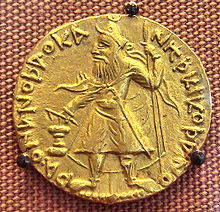Kanishka

Kanischka I. ( Graeco-Bactrian : Κανηϸκο ; * 53 (?); † 126 (?) AD) or Kanischka the Great , was emperor of the Kushan dynasty in the second century (approx. 127-150 AD) .). He is famous for his military, political and spiritual achievements. Kanishka, a descendant of Kujula Kadphises , the founder of the Kushan Empire, gained control over an empire in Bactria that stretched as far as Pataliputra in the Ganges plain through his descent . The capital of his empire was in Puruṣapura (today's Peshawar ), another large capital in Kapisa (near today's Kabul ).
His conquests and patronage over Buddhism played an important role in the development of the Silk Road and in the transmission of Buddhism from his empire to China via the Karakoram Mountains.
Chronological order
Kanishka's exact chronological classification is unclear, as he and his successors used a time calculation in their inscriptions that so far cannot be precisely linked to fixed dates. His reign is therefore classified later than given above (e.g. from Ghirshman to 144–168 AD). Apparently Kanishka imitated some coins of the Roman emperor Hadrian (r. 117-138), which speaks for a contemporary; his son Huvischka imitated the coins of Hadrian and Antoninus Pius . In 1993 the Rabatak inscription was found in Afghanistan , the content of which allows further conclusions to be drawn about him and his time. This is a so-called Annunciation inscription, written in Greek and Bactrian, which reports in Rabatak near Surkh Kotal in Afghanistan about the spread of his faith, the country he ruled, his gods and his origin.
Historical meaning
King Kanishka from the Kuschana dynasty was the most important ruler of the Yuezhi or Tocharer , who established a huge empire in Bactria and Gandhara around the birth of Christ . Under Kanishka, this flourishing state reached its peak in the 2nd century, shaped by Iranian, Indian and Hellenistic influences and just as many gods.
Kanischka enlarged the empire towards Turkestan and Kashmir and expanded in northern India to the area around Varanasi . In Turkestan he is the Kushan have restored -Oberhoheit: His predecessor was due to a failed to materialize Marriage conjunction with the Han in 90 an army against their generals Ban Chao sent († 102), but could prevail nothing, after which he decided to pay tribute . Kanischka stopped these tribute payments.
Kanishka also paid homage to Greek , Brahmanic and Zoroastrian deities, but he gained importance mainly because of the fourth great council , which he had held in Kashmir (according to other opinions in Kuvana near Jalandhar ). This council is considered to be the beginning of Mahayana Buddhism . The presidents were the theologian Vasumitra and the poet Ashvaghosha . Besides Buddhism, Kanishka was also close to the Mithras cult .
According to tradition, Kanischka is ascribed a behavior similar to that of the earlier King Ashoka (ruled approx. 268–238 BC) - cruelty in youth and piety in old age. However, Kanishka was not quite as peaceful and willing to give as Ashoka four centuries before him. The legend traces its end to a popular uprising because of a planned war campaign, he was suffocated in a sick bed.
buildings
At Peshawar , which Kanischka made its capital and winter residence, the so-called Kanischka-Stupa , a supposedly 13-story stupa with a height of over 100 m, was built. The king's summer residence was in grief . At Surkh Kotal in today's Afghanistan there was a large fire temple, a sanctuary that was also dedicated to the ruler's cult. The inscriptions there were published by Robert Göbl , who as a numismatist mainly dealt with the coins of the Kanischka. Another mention of his name can be found on the so-called Kanischka reliquary .
literature
- AK Narain: Indo-Europeans in Inner Asia , In: Denis Sinor (Ed.): The Cambridge History of Early Inner Asia , Cambridge 1990, ISBN 0-521-24304-1 , pp. 164-166.
Web links
Individual evidence
- ^ Robert Bracey: The Date of Kanishka since 1960 (Indian Historical Review, 2017, 44 (1), 1-41) . In: Indian Historical Review . 44, 2017, pp. 1–41.
| predecessor | Office | successor |
|---|---|---|
| Vima Kadphises |
Rulers of Kushana 100–126 |
Huvischka |
| personal data | |
|---|---|
| SURNAME | Kanishka |
| ALTERNATIVE NAMES | Kanishka I. |
| BRIEF DESCRIPTION | Great King of the Kushana |
| DATE OF BIRTH | at 53 |
| DATE OF DEATH | at 126 |

